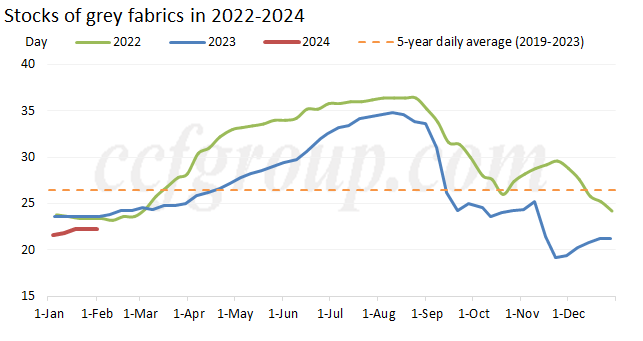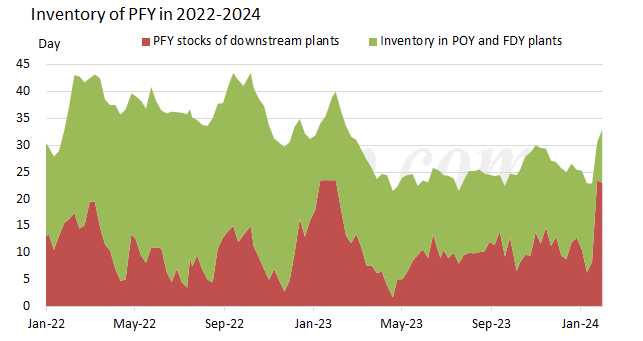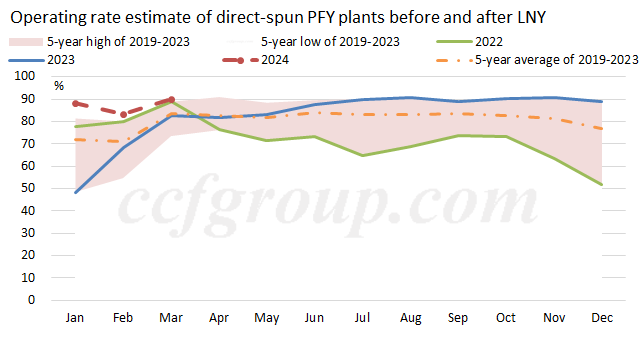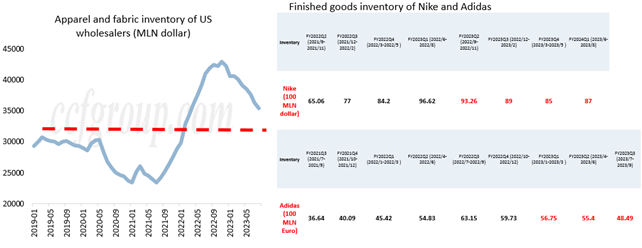Probe into demand for polyester in 2024
The real downstream demand may have been pulled forward and it is suggested to be not too optimistic about status after the Spring Festival holiday.
Why were textile companies busy before the Spring Festival (Feb 10)? One reason is that the Chinese New Year fell later this year, and normal production and work resumption will not happen until the end of February. By that time, spring clothing will be widely released, and the production of summer clothing will enter a full-scale phase. Therefore, it is necessary to place advance orders for spring and summer domestic sales before the Chinese New Year. Another main reason is the recovery of foreign trade orders, with a significant portion of these orders possibly coming from advance orders during the month of Ramadan.
This year's Chinese New Year is later than last year, but overseas Ramadan began ten days earlier. This means that sellers have a shorter time to prepare inventory. If they wait until after the Chinese New Year for factories to resume work, they may miss out on the Ramadan buying frenzy. Furthermore, during Ramadan, governments and businesses in Muslim countries adjust their working hours, including customs, ports, and other institutions and companies. This may cause delays in import and export operations. Therefore, sellers must place orders and prepare inventory before the Chinese New Year, aiming to have the goods arrive at the destination port before Ramadan starts. This is another major reason for the busy textile company orders before the Chinese New Year.
Compared with the same period in 2023, it is believed that there is a possibility of weakening demand after 2024 Spring Festival. First of all, the release of the backlog of demand weakens, including hotel renovation, wedding demand and so on.Secondly, the completed area of real estate has reduced significantly, resulting in a weakening of demand for home textiles and home decoration in the post-cycle.Once again, India's BIS certification has not yet made further progress. Coupled with the shipping market interference brought about by the Red Sea crisis, the PFY exports have failed to continue the high growth in recent months. Finally, with late Spring Festival this year, some orders are mainly orders for Ramadan and the pulled-forward of some domestic orders.
In summary, it is not suggested to be too optimistic about the downstream demand after Spring Festival holiday.
The inventory of the whole industrial chain is healthy and the replenishment demand may remain in the first half of 2024
The inventory of the whole industrial chain decreased well driven by high growth rate of demand in 2023. Currently, the inventory of polyester products, grey fabrics, textiles and apparels is healthy. Therefore, in expectation of lower real demand in the first half of 2024, the replenishment demand is critical for the whole industrial chain. The restocking on the whole industrial chain may not continue until at least in the first half of 2024. After downstream plants resume normal operation after Spring Festival, the operating rate is estimated to be high by early-Mar and the inventory of the whole industrial chain may rise further.

Polyester companies may encounter big inventory burden after the Spring Festival holiday. How to destock will be the key tone in the following months.
Downstream plants successively started Spring Festival holiday from the last week of Jan. The operating rate of downstream plants in Zhejiang and Jiangsu sped up to fall and non-local workers successively returned hometown for holiday. By end-Jan, most downstream factories have shut down for holiday and the rest will start holiday on Feb 2-5. As for the resumption after holiday, according to the survey made by CCFGroup, normal production may appear after the Lantern Festival (Feb 24), similar to the status in history, with some earlier on Feb 17-21, not earlier than anticipation temporarily. The Spring Festival holiday schedule of downstream plants is averaged at 20-25 days, not short.
Most downstream buyers have finished restocking now, with PFY stocks averaged at around 23 days. Sporadic replenishment may emerge later. The PFY stocks of downstream plants can be 24 days before the Spring Festival, similar to the strength in 2023. If normal production starts from the Lantern Festival on Feb 24, the PFY stocks can theoretically guarantee production until Mar 15-20. However, the polyester polymerization rate is estimated to hike over 2023. That means PFY companies are likely to see long-term sluggish sales. Coupled with high inventory at hand now, polyester enterprises may face high inventory burden in end-Feb/early-Mar, which may be higher than the high level after Spring Festival in 2022 and 2023. How to destock will be a key tone on polyester market in Mar-May.

High polyester polymerization rate can foresee in Mar-Apr but it may face pressure in May-Jul if destocking is unsmooth.
Polyester companies are expected to face some inventory burden after the Spring Festival holiday but high polymerization rate can be foreseen in Mar-Apr. Based on current turnaround plan of polyester companies, if the resumption is smooth, the polyester polymerization rate may be 90% in early-Mar and averaged at around 90% in Mar and slightly rise in Apr. High operating rate and inventory may coexist in Mar-Apr during the traditional peak season. During this process, destocking progress should be noted. If the destocking is unsmooth in Mar-Apr, the polyester polymerization rate will face pressure in May-Jul and high run rate may not sustain.

Overseas replenishment should be concerned in the second half of 2024 and the recovery of foreign trade decides the demand for polyester products.
The real demand may be modest in the first half of 2024 but the replenishment is likely to be continued. The inventory of the whole industrial chain may increase in the second half of year and foreign trade will be crucial. According to related data, overseas market is at the end of destocking, still around 20% higher than the normal inventory level. The foreign trade is expected to recover limitedly in the first half of 2024 and the status in the second half of year should be highly concerned. Whether the foreign trade can apparently improve depends on the retail sales of downstream products abroad. Only when retail sales grow later will overseas market enter passive destocking and active replenishment.

- Top keywords
- Cotton Price
- Cotton Futures Price
- Cotton Futures
- CZCE
- PTA Futures Price
- Chemical Fiber
- Polyester Prices
- Wool price
- PTA Futures
- Shengze Silk
- China
- Yarn Price
- price
- China Textile City
- Fibre Price
- Benzene Price
- Cotton
- Index
- Cotton Index
- PTA
- fabric price
- NYMEX
- Top 10
- textile industry
- Spot Cotton
- Cotton Yarn
- Polyester Price
- Futures
- PTA Price
- cotton yarn price

